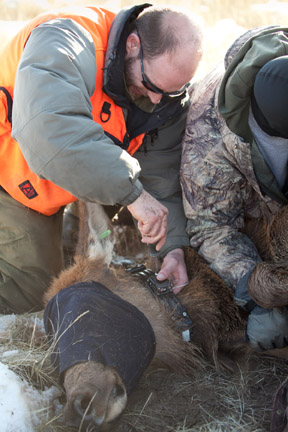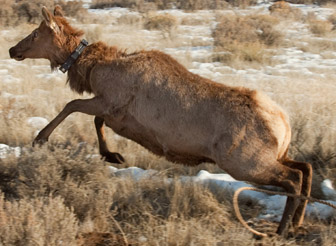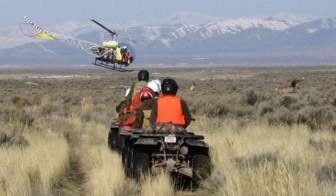Idaho State University study at INL could shed light on effects of climate change on elk
April 14, 2010
A herd of elk that has established itself on the Idaho National Laboratory Site in Eastern Idaho may provide scientists with clues about how climate change could affect elk in more traditional habitats.
Idaho State University biological sciences doctoral student Ryan Long is comparing the habits and patterns of behavior of 20 elk that were recently fitted with GPS collars in the Southeast Idaho desert on the Idaho National Laboratory lands with the habits of 30 elk that have been fitted with GPS collars at the Starkey Experimental Forest in northeast Oregon near La Grande.
 The first year of this three-year study is being funded by the Department of Energy through Stoller’s Environmental Surveillance, Education and Research Program.
The first year of this three-year study is being funded by the Department of Energy through Stoller’s Environmental Surveillance, Education and Research Program.
Results of this study will be included as part of the Conservation Management Plan for the Idaho National Laboratory that Stoller is drafting for the Department of Energy. The Idaho Department of Fish and Game will also have access to the data to use in its management plan. The IDFG has already assisted with the project, helping to collar the animals.
“In the broader sense, one of the main things I’m trying to do with this study is to evaluate the potential effects of climate change on elk,” Long said. “There aren’t many elk herds that live in the middle of the desert – the INL herd is unique – and these animals are exposed to substantially higher temperatures and solar radiation than elk occupying more traditional forested habitat. I will be evaluating effects of the thermal environment on elk, with the goal of learning how elk in more classic habitat may respond to global warming.”
 The elk have been fitted with collars that have Global Positioning System (GPS) devices that collect a variety of data every hour, including the elks’ location and the air temperature. Next fall, the collars will be released remotely and then collected.
The elk have been fitted with collars that have Global Positioning System (GPS) devices that collect a variety of data every hour, including the elks’ location and the air temperature. Next fall, the collars will be released remotely and then collected.
The DOE and the IDFG will use the data collected from the collars to address a variety of management issues and to learn basic information about the herd, including the location of calving grounds (where calves are born and raised in early life) and other critical habitat, as well as the animals’ patterns of movement.
Biologists aren’t sure how large the INL herd is, but Long estimated it is about 300 animals. The herd established itself in the 1980s. Prior to that time elk only migrated through the area, not taking up permanent residence.
 With the help of Idaho Department of Fish and Game, researchers conducted a net-gunning operation over two days in March to collar the elk. Net gunning is a complicated, but effective way to capture elk. An airplane pilot and spotter searched for elk in a 200-square mile area within the site’s 890 square miles. When elk are spotted, a helicopter pilot is directed to that location, where the pilot sorts the herd and selects females for capture from the air. The gunner fires a net from the chopper, and after landing, a third person, called a mugger, exits the helicopter and restrains the netted elk until a ground crew arrives, according to a Stoller press release.
With the help of Idaho Department of Fish and Game, researchers conducted a net-gunning operation over two days in March to collar the elk. Net gunning is a complicated, but effective way to capture elk. An airplane pilot and spotter searched for elk in a 200-square mile area within the site’s 890 square miles. When elk are spotted, a helicopter pilot is directed to that location, where the pilot sorts the herd and selects females for capture from the air. The gunner fires a net from the chopper, and after landing, a third person, called a mugger, exits the helicopter and restrains the netted elk until a ground crew arrives, according to a Stoller press release.
“The first one I did, I bounced off of three or four times before I actually got her to go down,” Long said. “They weigh anywhere from 300 to 500 pounds and I’m sitting right around 160 so they definitely have the advantage.”
Ground crews were responsible for safely collaring the elk before releasing them back into the wild. Blood samples, body measurements and temperature were gathered in a matter of minutes while elk were down. Elk can overheat easily so snow was constantly packed around the animals to keep body temperature stable. It takes a team of three to six people to hold and handle one elk until the collar is in place and all other data are collected. As soon as the team released its hold on the elk, the animal jumped to its feet and ran away.
Video of this net gunning operation is available for viewing at Stoller’s website, http://www.stoller-eser.com/videos.
###
About Idaho State University
Idaho State University, a Carnegie-classified doctoral research institution founded in 1901, educates approximately 15,000 students per year in more than 280 programs. It is Idaho’s lead institution in health professions and medical education. Its seven colleges engage in a broad range of innovative research, teaching, and learning in the natural and physical sciences, humanities, performing and visual arts, education, engineering, business, pharmacy, and technology. Visit ISU today at www.isu.edu.
Categories:
